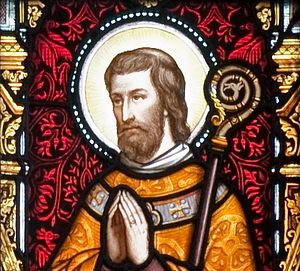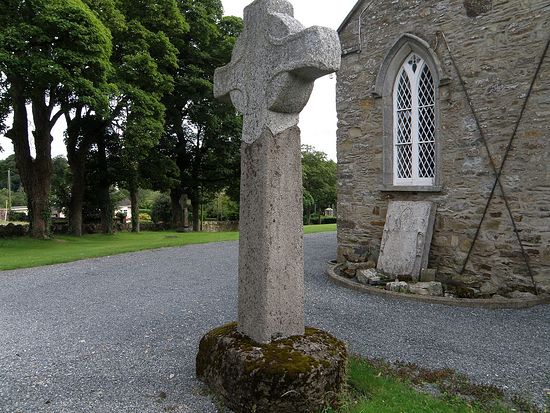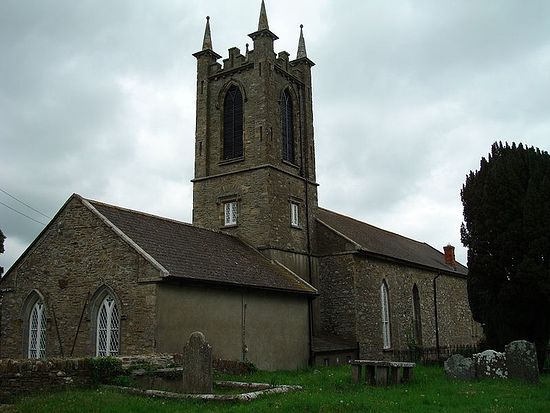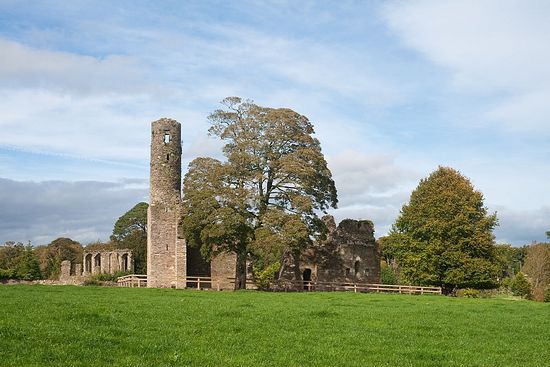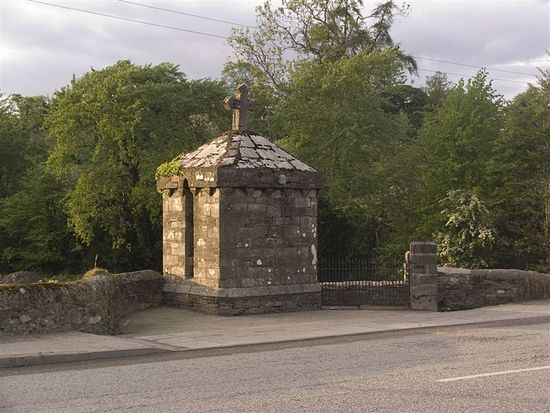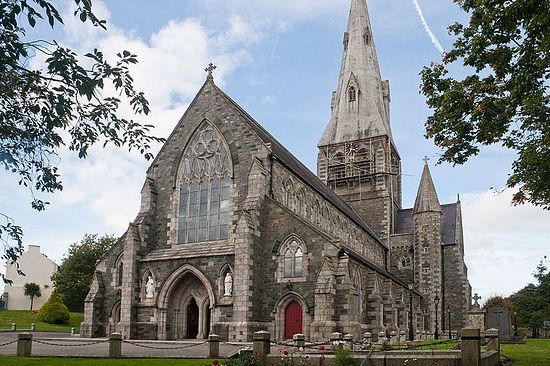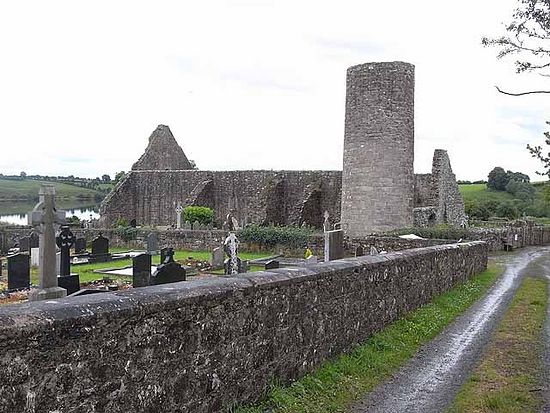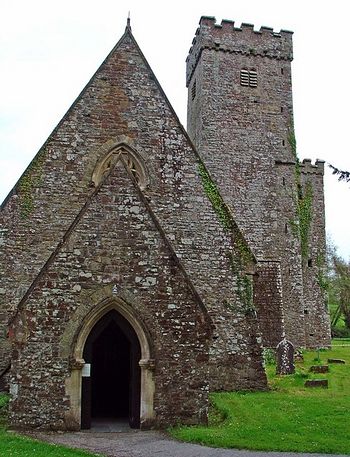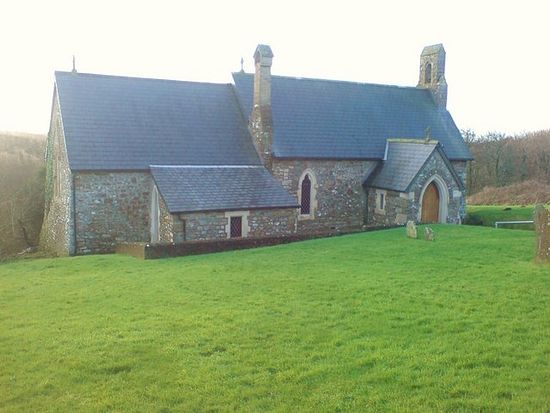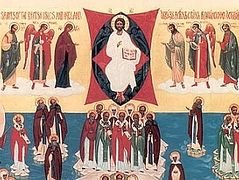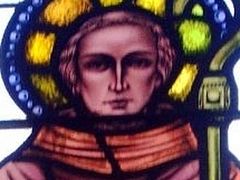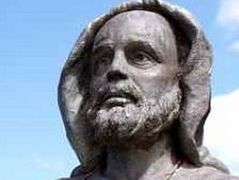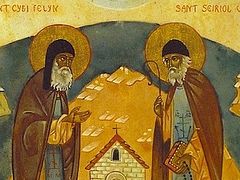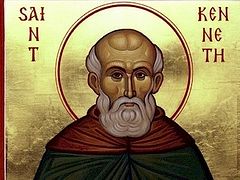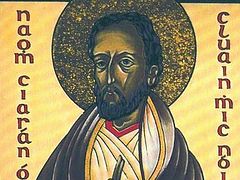There are a number of later Lives of this saint, written several centuries after his death, however, earlier traditions associated with him are more reliable. He is mentioned in many early annals and calendars and also in Lives of other contemporary saints.
According to one version, St. Aidan (also Maedoc, Mogue, Aedh) was born in the mid-sixth century in the ancient Irish kingdom (and later province) of Connacht in the west of what is now the Republic of Ireland. According to another version, his birthplace was an isle (now called St. Mogue’s Island after him) in the Templeport Lake in what is now county Cavan in the north of the Republic of Ireland which then was the south of the kingdom of Ulster. The saint was of a noble origin: his father’s name was Setna and mother bore the name Eithne, while one of his cousins was a saint with the name Dallan Forgail, a prominent Irish poet, who composed a touching panegyric on St. Columba and who for part of his life was blind (he was finally martyred by pirates in 598 and is celebrated on January 29/February 11).
It was said that some time before St. Aidan’s birth there was a vision of a bright star descending at night from heaven and falling on each of his parents while they were sleeping, and it was a sign of the greatness of their future son. An ancient tradition relates that there was no boat on the isle to deliver the newborn Aidan to mainland Ireland so that he could be baptized. Then he was miraculously brought to the Irish shore on a stone and was successfully baptized. Local residents believe that the baptismal font of a parish church of the neighboring Bawnboy (meaning “cattle-enclosure”) village in county Cavan is made from that very stone.
In his youth St. Aidan was foretold that in the future he would become a bishop. As a young man Aidan spent some years in the kingdom (later province) of Leinster in southeastern Ireland. There he obtained his education and read the Scriptures almost perpetually. He also probably studied at the most famous Monastery of Clonard, founded by St. Finian. After that, as the saint’s biographers wrote, “guided by a strong desire to gain deeper knowledge of the divine sciences,” Aidan moved to Wales where he was tonsured a monk and lived the ascetic life at Mynyw (now St. Davids) in Pembrokeshire together with St. David, the patron saint of that country. St. Aidan continued his studies under St. David for several years before returning to Ireland in about 580.
In the year 597 St. Aidan became the first bishop of Ferns (which means “alder trees”) in what is now County Wexford in Ireland. The holy hierarch was so loved and esteemed by everybody that with time he became the main bishop of the whole of Leinster. On lands endowed by a local ruler in Ferns, St. Aidan built a monastery which became very famous, and served as its first abbot. The man of God undertook a large-scale mission and church-building activity across several regions of Ireland. Thus, he founded Drumlane Monastery in Cavan (although, according to another version, this monastery was established by St. Columba), Rossinver in Connacht (now in County Antrim) as well as no fewer than thirty churches in Ireland. The foundation of a monastic community at his supposed birthplace on St. Mogue’s Island in Cavan is attributed to him as well.
Today this island is still a very quiet place. The ruins of an early church are visible here to this day. Many residents wished to be buried on this holy spot down the centuries so the local cemetery grew very big. It is believed that clay or simply earth from among the church ruins protects people from fires and drowning. Some Irish people like to keep clay from this island in their homes. A truly remarkable historical example is the miracle that happened to Mary McGovern (1890-1957), a native of County Cavan, who in 1912 was one of the passengers on the Titanic and survived, according to her own evidence, only due to the miracle-working power of soil from St. Mogue’s Island, some of which she had wrapped and taken with her on her journey. Later this woman returned to her native Ireland and lived there until her death, always keeping the “St. Mogue’s clay” with her.
St. Aidan of Ferns is also credited with founding a monastery in what is now County Waterford in the former province of Munster (southeast Ireland) and another monastery in the Limerick region in southwest Ireland. For some time he may also have ruled the monasteries of Kilkenny and Fiddown in what is now County Kilkenny in Leinster. He was greatly venerated in all these places, as in other regions of the country. According to much later versions of his Life, after many years of illustrious labors in Ireland St. Aidan went back to Wales where he most probably founded a monastery. The Holy Hierarch David of Mynyw, according to tradition, died in the arms of Aidan. Some of his biographers claimed that Aidan even succeeded St. David as Abbot of Mynyw Monastery.
Let us now say a few words on the personal qualities of St. Aidan. He was noted for his learning, obedience and humility, inclination to asceticism, fine abilities as an abbot and administrator, and loving care for others; however, he could be very strict when needed. The saint always taught his monks to share all, even their last bits of food, with the poor and hungry: “Give as generously as if you possessed all the pastures in the mountains of Ireland,” he used to say. The holy man had a special fondness of animals and always protected them, reproving hunters who killed them not out of necessity. It is known that once due to his prayers a deer became invisible and thus was saved from its pursuers. That is why St. Aidan is often depicted with a deer.
It was also said that the saint loved the austere ascetic life so much that over whole seven years his diet consisted of only barley bread and water. Meanwhile, he often managed to read the whole Psalter several times in a single day. As was the case with St. Columba and other Irish saints, St. Aidan could see what was happening to his disciples even at great distances and saved them by his prayer from imminent death (thus he saved one monastery worker who fell before a plow dragged by oxen and many others). Once the saint took pity on a poor servant who was laboring for his master in a field under extremely harsh conditions. He gave the servant half a measure of barley, which at once turned into gold. The poor man rushed to his master, offered him this gold and was at once freed.
Once a group of cheats decided to deceive St. Aidan: They dressed in paupers’ clothes and started begging in the saint’s presence. But Aidan saw in spirit that they were resorting to trickery—he ignored them and ordered to give out the alms that he had with him to those who really needed it. On several occasions St. Aidan even brought dead people back to life by his prayers and in many cases protected the oppressed. There is a touching story of how St. Aidan blessed the hands of one unskilled but pious man named Goban before building Ferns Monastery, and the latter at once became a brilliant architect, who soon built an excellent church in Ferns as well as many other beautiful churches in Ireland.
The fruitful ministry of St. Aidan of Ferns in Wales and Ireland lasted for over fifty years; the saint converted many people to Christ, gained hundreds of disciples, established many churches and monasteries and worked countless miracles. Most scholars believe that St. Aidan reposed in Ireland, near the Rossinver Monastery he had founded, on January 31 (according to the old calendar), 632 (though some annals give 624, 625 and 626), reaching a very advanced age. Yet other late sources suggest that he reposed in Wales. After his death his holy relics were venerated in Ferns, and possibly Drumlane and Rossinver—the three monasteries that were closely connected with him. The veneration of St. Aidan in Wales was as popular as in Ireland. This holy bishop is also venerated in Scotland; there he is recalled in such place-names as St. Madoes village in the Perth and Kinross area (where there is a parish church and an early Pictish stone cross with the same name).
According to tradition, the man of God bequeathed his personal handbell and staff (crozier) to his monasteries, which was a common practice of many Celtic saints. By a miracle of God, all these relics associated with him survive to this day—his staff is kept in the National Museum of Ireland in Dublin,1 and his bell and earliest reliquary are in the library of Armagh Cathedral. Among the spiritual heirs of St. Aidan of Ferns let us mention St. Moling, the second Bishop of Ferns and founder of St. Mullins Monastery in county Carlow (feast: June 17/30). It was St. Moling who blessed a holy well in honor of St. Aidan in Ferns.
Today, the Anglican Cathedral (Church of Ireland) in the Irish town of Ferns is dedicated to St. Aidan. It is considered to be the smallest Cathedral in Western Europe. It stands on the site where our saint built his first, Orthodox monastery, in the late sixth century. A Catholic Cathedral appeared on this site in 1230. In 1575 this Cathedral was destroyed and a Protestant Cathedral was subsequently built in the same place. The present Cathedral, officially dedicated to “St. Edan”, claims the saint’s bodily relics. Apart from this cathedral there are many other notable Christian sites in this quiet town (which once was the capital of Leinster and has ever been a holy place): an Augustinian abbey of the twelfth century, some ruins of the ancient cathedral, a number of early crosses, St. Peter’s Church, St. Aidan’s modern Catholic Church, a modern Catholic Convent of St. Aidan and the Adoration, and a holy well of “St. Mogue”.
The magnificent nineteenth-century Roman Catholic Cathedral in the Irish town of Enniscorthy in County Wexford is dedicated to our saint. The Cathedral was built according to the design of the prominent English architect Augustus Welby Pugin (1812-1852) and contains, among other treasures, a well-known stained glass image of St. Aidan and many other windows.
The holy hierarch is the patron of Ferns and the parish of Templeport in County Cavan. The small village of Bawnboy, mentioned above, annually celebrates St. Aidan’s memory as well. A parish church situated nearby bears the name of St. Aidan (Mogue) and local residents make annual pilgrimages to the lake isle where he was born, according to one version of his Life.
There is a village of Milltown in County Cavan. The famous Drumlane Monastery, mentioned above, was located just to the south of it. This monastery was closely associated with St. Columba of Iona (before his move to Scotland), St. Aidan of Ferns and many other saints. The first wooden Irish Orthodox monastery was founded here in the sixth century. Austin canons came here in the twelfth century and built their stone Catholic abbey. The latter, however, was largely destroyed in 1260. Today a church, a fine Celtic round tower (the most splendid in the county) along with monastic ruins can be found there.
“Aidan” is still a popular boys’ baptismal name in County Cavan. This saint should not be confused with Saint Aidan of Lindisfarne, the Wonderworker and Apostle of Northumbria, who bore the same name, was an Irishman, and is venerated particularly on Lindisfarne in Northumberland in northeastern England. He is also one of the greatest Celtic saints and is feasted on August 31/September 13.
There is a village with the name Llawhaden (perhaps meaning “Aidan’s monastic enclosure”) in the Welsh county of Pembrokeshire in the west of the country. The village has a parish church of St. Aidan near the Eastern Cleddau River. St. Aidan may have founded this church; his name is also connected with the settlements of Nolton and Haroldston West nearby with their churches dedicated to “St. Madoc” who is identified with our saint. Thus the memory of the fact that St. Aidan of Ferns was a disciple of St. David, the patron of Wales, is preserved here.
Holy Hierarch Aidan of Ferns, pray to God for us

